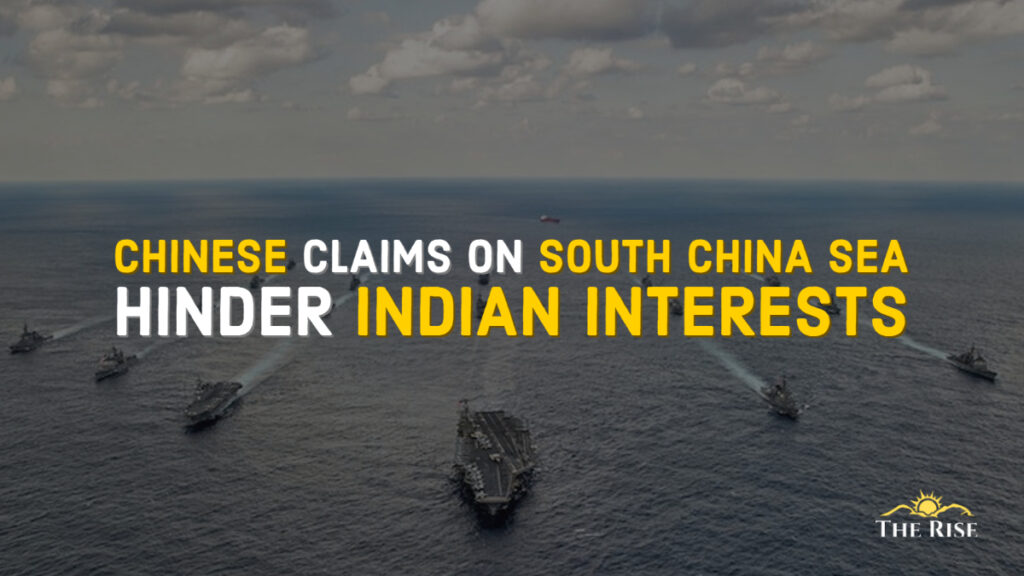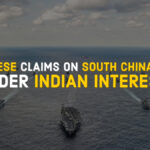The continued flow of commerce and naval movement in the South China Sea is vital for India. It handles around 55% of India’s trade with the Indo-Pacific region. Sustaining regional peace and stability is, thus, crucial for India. To counterbalance China’s ambitious Belt and Road Initiative (BRI) effort, India must leverage its geographical advantage, increasing its naval profile, ASEAN collaboration, and heritage of goodwill.
China and numerous other Governments have competing land and marine sovereignty claims in the South China Sea. Despite the Permanent Court of Arbitration in The Hague rejecting China’s claims of historical “exclusive control” over the sea, they persist. Many non-claimant states, like India, want the South China Sea to remain open as international seas.
Being the second busiest sea lane in the world, the South China Sea carries around one-third of global shipping (nearly $3 trillion). It has increased the trade and economic relations with various East Asian states as well as the Pacific region. Control of this sea route would benefit a single country economically and militarily. As a result, this area can be used to win control over the rest of Asia. Among China’s opponents are the Philippines, Vietnam, Brunei, Malaysia, and Taiwan.
The “nine-dash line” claims most of the South China Sea for China. The loop encircles various islands from China to Malaysia and Singapore, including the Spratly and Paracel chains.
China uses a delaying strategy to consolidate its claims over the South China Sea. Also, it may resist any regional counterbalancing coalition led by the USA.
Also Read: Indian Ocean and South China Sea: Jugular Vein as Gordian Knot
With increasing political, military, and economic dominance, Beijing will undoubtedly utilise it to pursue its own interests to the detriment of other nations. China uses a delaying strategy, in which a state maintains its claims over the contested area, without providing concessions or deploying force to consolidate its claims while preventing other states from doing likewise. The passage of time strengthens a state’s claim under international law if it holds contested land as part of a delaying strategy. Achieving better relations with neighbouring states trumped the contested maritime rights and islands in the South China Sea. Mao ordered the transfer of the disputed Bailongwei (White Dragon Tail) Island to North Vietnam in 1957 to boost Sino-North Vietnamese relations. It’s unlikely, but it’s possible. For example, China may resist any regional counterbalancing coalition led by the USA. Affected countries may expect China to make some concessions to mend relations.
Indian Interests
Despite not being physically located in the South China Sea region, India is strongly involved with numerous littoral states in the region due to geoeconomic and geopolitical interests. India considers the South China Sea to be its “extended neighbourhood” and has reached out to its neighbours.
A Chinese assessment puts the South China Sea’s oil reserves at 130 billion barrels, second only to the reserves of Saudi Arabia. To expand long-term cooperation in the oil sector, India’s state-run explorer, Oil and Natural Gas Corporation (ONGC) signed a letter of intent with Petro Vietnam on September 15, 2014. ONGC Videsh Limited (OVL) entered Vietnam in 1988 with Block 06.1. The government also granted two exploration blocks to the corporation in 2006. Block 127, being unprofitable, was abandoned, although the other block is still being investigated and closely correlates to the current Chinese escalation area.
Also Read: The Iran–China 25-years Deal: Where does it leave India?
Continued flow of commerce and naval movement in the South Chinal Sea is vital for India
The continued flow of commerce and naval movement in the South China Sea is vital for India. It handles around 55% of India’s trade with the Indo-Pacific region. Thus, sustaining regional peace and stability is crucial for India.
The South China Sea connects the Indian and Pacific Oceans. As India’s maritime cooperation with the US and Australia grew, the importance of Indo-Pacific region increased. The Indian Navy now joins the US and Japanese navies in the Western Pacific. As a result, India needs secure access to the South China Sea. India needs unhindered passage via the South China Sea to reach the Western Pacific.
To counterbalance China’s ambitious Belt and Road Initiative (BRI) effort, India must leverage its geographical advantage, increasing its naval profile, ASEAN collaboration, and heritage of goodwill. This is the rationale for India’s response to the South China Sea issue. India hopes to impede China’s ambitions in the South China Sea by creating a cooperative security alliance that complements ASEAN’s indirect balancing of China. With its weight behind countries, like Vietnam, which are embroiled in a dispute with Beijing over overlapping claims to sovereignty in the South China Sea, India’s “Look East Policy” (LEP) and “Act East Policy” (AEP) compliment India’s strategy of containing Chinese footprints in its “extended neighbourhood.” The Look East Policy (LEP) and Act East Policy (AEP) have helped strengthen India-ASEAN ties. It has also paved the way for India’s growing involvement and responsibilities in Indo-Pacific affairs.
Also Read: Abraham Accord and its Geopolitical Significance
India, the US, Australia, and Japan hosted the inaugural virtual Quadrilateral Security Dialogue (Quad) summit early this year, where they vowed to cooperate on cybersecurity and maritime challenges. Logical constructivism tempered by critical, practical geopolitical imperatives would be best suited to India.
Disclaimer: The views expressed in this article are of the author solely. TheRise.co.in neither endorses nor is responsible for them.
About the author
Neeraj Singh Manhas is a Director of Research, Indo-Pacific Consortium, at Raisina House, New Delhi. He has authored four books under his name and has various research interests covering India-China in the Indian Ocean, India's maritime securities, and Indo-Pacific studies.
















Pingback: Achilles' Heels of China in 2022 - TheRise.co.in
Pingback: In Search of Allies: Washington and the World - TheRise.co.in
Pingback: Lessons for Taiwan from Russia-Ukraine Conflict - TheRise.co.in
Pingback: Decoding Yi’s Visit to India - TheRise.co.in
Pingback: Decoding China's Hegemony in Indo-Pacific - TheRise.co.in
Pingback: Analysing Maritime Domain Awareness - TheRise.co.in